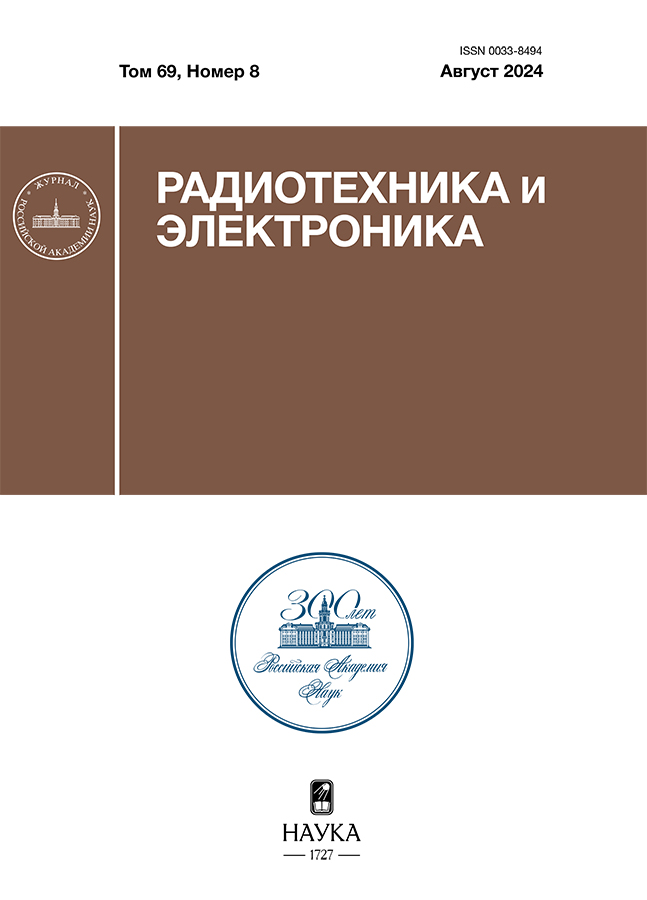Adaptation of detection thresholds based on the results of multi-frame accumulation radar signals against the background of non-gaussian noise
- 作者: Koshelev V.I.1, Belokurov V.A.1
-
隶属关系:
- Ryazan State Radiotechnical University named after V.F. Utkin
- 期: 卷 69, 编号 8 (2024)
- 页面: 802-808
- 栏目: К 90-ЛЕТИЮ М.С. ЯРЛЫКОВА
- URL: https://bulletin.ssaa.ru/0033-8494/article/view/684811
- DOI: https://doi.org/10.31857/S0033849424080106
- EDN: https://elibrary.ru/HNTNLE
- ID: 684811
如何引用文章
详细
An algorithm for stabilizing the false alarm rate is proposed, based on the approximation of the probability distribution density of the decisive statistics counts during multi-frame accumulation against the background of noise described by the Rayleigh and Weibull distributions. It is shown that the proposed algorithm for stabilizing the false alarm rate is adaptive and invariant to the noise distribution law.
全文:
作者简介
V. Koshelev
Ryazan State Radiotechnical University named after V.F. Utkin
Email: belokurov.v.a@rsreu.ru
俄罗斯联邦, Gagarin str., 59/1, Ryazan, 390005
V. Belokurov
Ryazan State Radiotechnical University named after V.F. Utkin
编辑信件的主要联系方式.
Email: belokurov.v.a@rsreu.ru
俄罗斯联邦, Gagarin str., 59/1, Ryazan, 390005
参考
- Сосулин Ю.Г. Теория обнаружения и оценивания стохастических сигналов. М.: Советское радио, 1978.
- Ширман Я.Д., Манжос В.Н. Теория и техника обработки радиолокационной информации на фоне помех. М.: Радио и связь, 1981.
- Arnold J. // IEEE Trans. 1993. V. AES-29. № 1. Р. 44.
- Бакулев П.А. Радиолокационные системы. М.: Радиотехника, 2015.
- Финкильштейн М.И. Основы радиолокации. М.: Радио и связь, 1983.
- Serine M. Weibull Radar Clutter. L.: Peter Peregrinus Ltd, 1990.
- Watts S. Sea Clutter: Scattering, the K Distribution and Radar Performance. L.: The Institution of Engineering and Technology, 2006.
- Марковская теория оценивания случайных процессов / Под ред. М.С. Ярлыкова. М.: Радио и связь, 1993.
- Радиоэлектронные комплексы навигации, прицеливания и управления вооружением летательных аппаратов. Т. 2. Применение авиационных радиолокационных комплексов при решении боевых и навигационных задач / Под ред. М.С. Ярлыкова. М.: Радиотехника, 2012.
- Johnson L. // IEEE Trans. 2002. V. AES-38. № 1. P. 228.
- Tonissen S. M., Evans R. J. // IEEE Trans. 1996. V. AES-32. № 10. P. 1440.
- Yi W. // IEICE Trans. Commun. 2013. V. 16. № 1. P. 291.
- Belokurov V.A., Koshelev V.I., Kagalenko M.V.// Proc. 2019 8nd Mediterranean Conf. on Embedded Computing (MECO). Budva. 10-14 Jun. N.Y.: IEEE, 2019. Paper No. 8760010.
- Кошелев В.И., Белокуров В.А. // Цифровая обработка сигналов. 2018. № 4. С. 50.
- Gumbel E. J. Statistics of Extremes. N.Y.: Mineola, 2000.
- Guida M., Iovino D., Longo M. // IEEE J. Selected Areas Commun. V. 6. № 1. 1988.
- Лихарев В.А. Цифровые методы и устройства в радиолокации. М.: Сов. радио, 1973.
- Coles S. An Introduction to Statistical Modeling of Extreme Values. L.: Springer, 2001.
- Castillo J. Estimation of Generalized Pareto Distribution. Statistics and Probability Letters. N.Y.: Elsevier, 2009.
- Cowan G. Statistical Data Aanalysis. Oxford: Oxford Univ. Press, 1998.
补充文件















